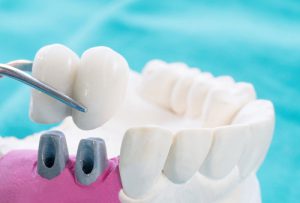Dental crowns, also known as dental caps, cover damaged or discolored teeth. Crowns cover the entire tooth, starting at the gum line. They are usually made of gold, porcelain, or a combination of both.
Although crowns can be made to improve the appearance of a tooth, in many cases, they are not primarily fabricated due to cosmetic reasons. Dentists recommend crowns to protect or strengthen weakened teeth, or to restore a disfigured tooth to its original shape. “Capping” a tooth requires buffing away part of a tooth to make room for the crown, so dentists often discourage it as a cosmetic method unless the teeth are damaged.
One of the options to replace missing teeth is utilising bridges. They are a fixed option which is a combination of crowns joined together. The supporting teeth have to be prepared for the crowns in order to bridge the gap.
Crowns strengthen teeth by binding the sides of the weakened tooth together, much the way a splint holds together a broken bone. Large fillings taking up over a third of the tooth may weaken that tooth over time; crowns are often used in cases where such weakened teeth threaten to break.
The “capping” procedure takes place under anaesthetic. Because the crown is about two millimeters thick, the dentist first shaves this same amount off your existing tooth to avoid awkward-looking, oversized teeth. The dentist will also re-shape your tooth into a form upon which a cap can easily sit. He or she will then make a replica of your tooth. Usually, this replica will be a putty mold. This mold is then sent to a laboratory, where the crown will be made based on this mold. In the case of a porcelain crown, the dentist will choose a shade close to the colour of the surrounding teeth. You will return about two weeks later to have the crown fitted and once both you and your dentist are satisfied with the look and aesthetics.



